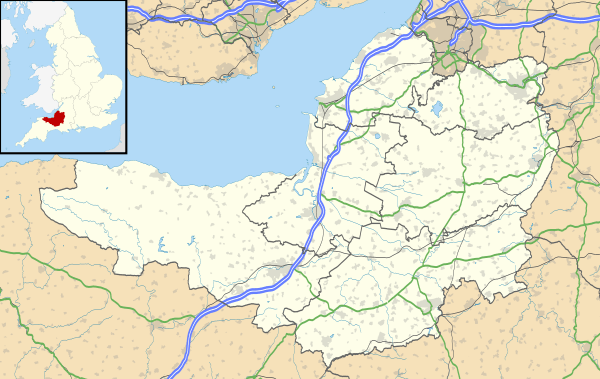Camerton Court
Camerton Court is a historic house in the village of Camerton, Somerset, England. It has been designated as a Grade II listed building.[1]
| Camerton Court | |
|---|---|
 Camerton Court from the lawn | |
| Location | Camerton, Somerset, England |
| Coordinates | 51°19′02″N 2°26′59″W |
| Built | 1840 |
| Architect | George Repton |
Listed Building – Grade II | |
| Official name: Camerton Court | |
| Designated | 1 February 1956[1] |
| Reference no. | 32673 |
 Location of Camerton Court in Somerset | |
House
The country house was built in 1835, designed by George Repton. It is constructed from ashlar, with a slate and concrete tiled roof. The building is two storeys with a porte-cochère with Tuscan columns at the front. From the garden the building has an octastyle colonnade with Ionic order columns, with a conservatory to the left.[2] The remains of the previous house were turned into a stable block, but have since become a separate home.[3]
The 8.1 hectares (20 acres) gardens were laid out in 1835 but was extensively remodelled in the 1980s.[3] the majority of the estate is parkland but there is a kitchen garden on the approach to the house, as well a small orchard. There are also a number of greenhouses on the site. The formal gardens include ornamental structures, a canal, gazebos and a pond with fountain.[3]
History
There has been a manor at Camerton since the reign of Alfred the Great, who granted the manor to the monks of Glastonbury. After the Norman conquest of England, William the Conqueror granted the manor to the Earl of Morton, who traded back to the monks of Glastonbury. The monks largely held the manor until 14th century, when it was passed between the Dinham and Paulton families. The Carew family held the manor between the 15th century and 18th century.[3]
The present house was built by John Jarrett, who purchased the property in the early 19th century.[4] and remained with the Jarrett family, to a design by George Repton (son of Humphry Repton), in 1838-40 replacing an earlier Manor House.[5] Violin maker Henry Lye worked as a carpenter at the estate for fifty six years.[4]
References
- Historic England. "Camerton Court and attached offices and gatepiers (Grade II) (1365682)". National Heritage List for England.
- "Camerton Court and Attached Offices and Gatepiers, Camerton". British Listed Buildings. Retrieved 31 August 2016.
- "Camerton Court, Bath, England". Parks and Gardens. Archived from the original on 11 September 2016. Retrieved 1 September 2016.
- Morris, William Meredith (1920). "British violin makers". British Violin Makers: A Biographical Dictionary of British Makers of Stringed Instruments and Bows and a Critical Description of Their Work with Introductory Chapters, and Numerous Portraits and Illustrations. Pelican Publishing. p. 192. ISBN 9781455601554.
- "Camerton Court and attached offices and gatepiers". historicengland.org.uk. English Heritage. Retrieved 4 December 2008.